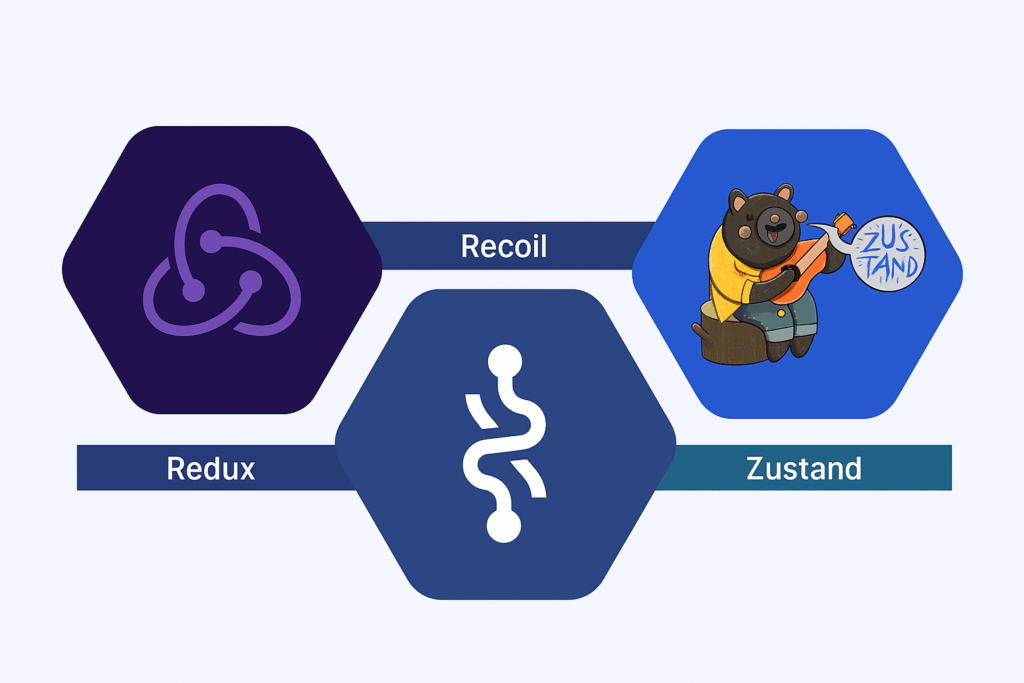Introduction
State management is a crucial aspect of building scalable and maintainable front-end applications. In React and Next.js projects, developers often face challenges in choosing the right tool for managing the application state. This blog explores three popular state management libraries: Redux, Recoil and Zustand comparing their strengths, limitations and ideal use cases in both React and Next.js applications.
Why State Management Matters
React’s built-in state is great for local component state, but as your app grows, managing shared and global state becomes harder. You’ll need a way to:
-
Share data across components.
-
Persist data between routes or reloads.
-
Avoid deeply nested props (prop drilling).
-
Optimize performance and avoid unnecessary re-renders.
Next.js adds routing, server-side rendering (SSR), and static site generation (SSG), so choosing a state management tool that works well with these features is also important.
Redux
What is Redux?
Redux is a predictable state container for JavaScript applications. It uses a centralized store and actions/reducers to manage application state.
Key Features:
-
Single source of truth.
-
Middleware support (like Redux Thunk or Redux Saga).
-
DevTools support.
-
Works with both React and Next.js.
Strengths:
-
Well-documented and widely adopted.
-
Great for large-scale applications.
-
Strong ecosystem.
Limitations:
-
Verbose boilerplate.
-
Requires understanding of actions, reducers, dispatch, and immutability.
Example:
// actions.js
export const increment = () => ({ type: "INCREMENT" });
export const decrement = () => ({ type: "DECREMENT" });
// reducer.js
const initialState = { count: 0 };
export const counterReducer = (state = initialState, action) => {
switch (action.type) {
case "INCREMENT":
return { count: state.count + 1 };
case "DECREMENT":
return { count: state.count - 1 };
default:
return state;
}
};
// store.js
import { createStore } from "redux";
import { counterReducer } from "./reducer";
export const store = createStore(counterReducer);
// Counter.jsx
import React from "react";
import { useSelector, useDispatch } from "react-redux";
import { increment, decrement } from "./actions";
const Counter = () => {
const count = useSelector((state) => state.count);
const dispatch = useDispatch();
return (
<div>
<button onClick={() => dispatch(increment())}>+</button>
<span>{count}</span>
<button onClick={() => dispatch(decrement())}>-</button>
</div>
);
};
export default Counter;
Recoil
What is Recoil?
Recoil is a state management library from Meta designed to work closely with React. It provides a way to share state across components using atoms and selectors.
Key Features:
-
Minimal boilerplate.
-
Fine-grained reactivity.
-
Asynchronous selectors for data fetching.
Strengths:
-
Easy to adopt for React developers.
-
Better performance with granular updates.
-
Great for component-level state sharing.
Limitations:
-
Still experimental (not yet 1.0 stable).
-
Smaller ecosystem compared to Redux.
Example:
import { atom, useRecoilState } from 'recoil';
const countState = atom({
key: 'count',
default: 0,
});
const Counter = ()=>{
const [count, setCount] = useRecoilState(countState);
return <button onClick={()=>setCount(count + 1)}>{count}</button>;
};
Zustand
What is Zustand?
Zustand (German for “state”) is a minimalistic and fast state-management tool built by the creators of Jotai and React Spring. It offers a simplified and flexible approach using vanilla JavaScript.
Key Features:
-
Minimal API.
-
Global state without context.
-
Built-in support for middleware.
- Server-friendly (ideal for SSR/SSG).
Strengths:
-
Extremely lightweight.
-
Easy to use and read.
-
Server-friendly (works with SSR/Next.js).
Limitations:
-
Less structure for complex state logic.
-
Smaller community.
Example:
import create from 'zustand';
const useStore = create((set)=>({
count: 0,
increment: ()=>set((state)=>({ count: state.count + 1}))
}));
const Counter = ()=>{
const { count, increment } = useStore();
return <button onClick={increment}>{count}</button>;
};
Using in Next.js Projects
When working with Next.js, SSR and SSG become important considerations:
-
Redux: Works well with SSR using libraries like
next-redux-wrapper. -
Recoil: Mostly client-side but can be used with SSR cautiously.
-
Zustand: Naturally supports SSR/SSG and is suitable for hybrid rendering.
For Next.js, Zustand is often preferred for its simplicity and SSR friendliness, especially in lightweight or static-heavy apps.
Comparison Table:
| Feature | Redux | Recoil | Zustand |
|---|---|---|---|
| Boilerplate | High | Low | Very Low |
| Learning Curve | Medium to High | Low | Very Low |
| Ecosystem | Mature | Growing | Small |
| SSR Support (Next.js) | Yes (with setup) | Limited | Yes (easy) |
| DevTools | Excellent | Basic | Available |
| Async State | Middleware | Selectors | Built-in |
When to Use What
-
Redux: For large-scale apps with complex state and long-term scalability.
-
Recoil: For modern apps with component-level granularity.
-
Zustand: For small-to-medium apps or when you need a quick, simple global state.
Conclusion
Choosing the right state management library depends on your project’s size, team familiarity, and SSR needs. Redux remains powerful for complex applications, while Recoil and Zustand offer modern, simpler alternatives that align with React’s evolving ecosystem especially when paired with frameworks like Next.js.
Experiment with all three to determine what best suits your needs. The React ecosystem is rich with options and that’s a great problem to have!
Source: Read MoreÂ


